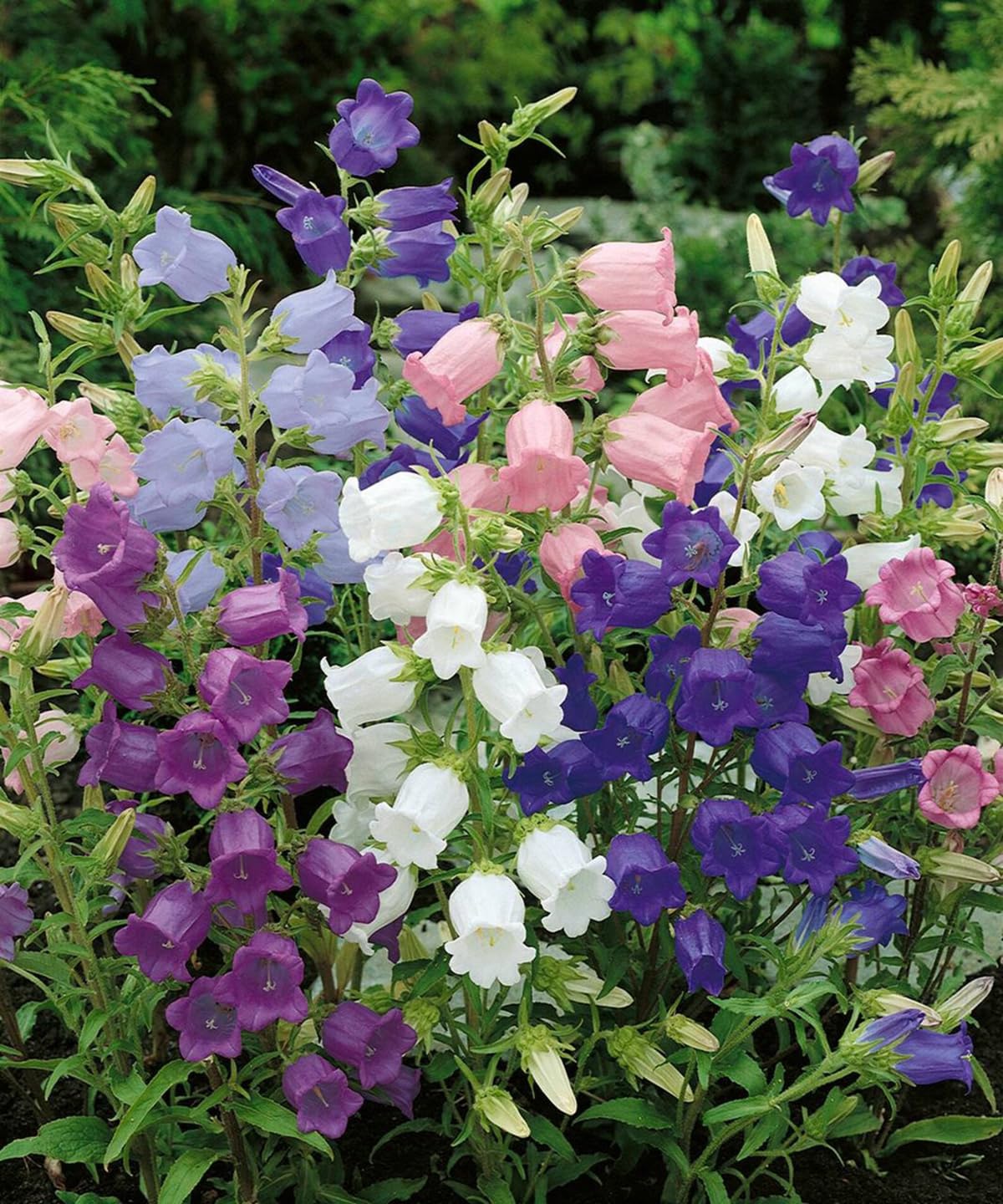Gardening enthusiasts, especially those with pets, often face the challenge of selecting plants that are both beautiful and safe for their furry friends. Canterbury Bells, also known as Campanula medium, offer a delightful solution. Known for their charming bell-shaped flowers, these plants not only enhance the aesthetic of any garden but are also non-toxic to both dogs and cats. This makes them a perfect choice for pet owners who wish to create a safe and vibrant garden environment.
Key Takeaways
- Canterbury Bells are non-toxic to both dogs and cats, making them a pet-friendly choice for gardens.
- These plants thrive in full sun to partial shade, offering flexibility in garden placement.
- Canterbury Bells can reseed naturally, providing a low-maintenance option for gardeners.
- The flowers are edible, adding a unique touch to culinary creations.
- Attracts butterflies and other pollinators, enhancing garden biodiversity.
Canterbury Bells: The Perfect Pet-Friendly Garden Flower
Canterbury Bells, with their vivid hues and elegant bell-shaped blossoms, are a favorite among gardeners who seek both beauty and functionality. These plants are not only visually appealing but also safe for pets, as confirmed by the ASPCA’s list of non-toxic plants. This makes them an ideal addition to gardens where pets roam freely.
Most importantly, Canterbury Bells do not contain any harmful compounds that could endanger your pets. Therefore, you can plant them with peace of mind, knowing that your garden is a safe haven for your four-legged companions. Moreover, these plants offer more than just safety; they add a splash of color and charm to any garden setting.
“Saucer Bell Flower Campanula Flowers …” from www.amazon.com and used with no modifications.
Benefits of Growing Canterbury Bells
Besides their pet-friendly nature, Canterbury Bells offer several other benefits that make them a worthwhile addition to your garden. Firstly, their vibrant flowers bloom in a range of colors, including purple, blue, pink, and white, adding a lively touch to your outdoor space. This diversity in color makes them a versatile choice for various garden designs and themes.
Additionally, Canterbury Bells are relatively easy to grow and maintain. They are biennials, meaning they will bloom in their second year, but they can also reseed themselves, providing continuous blooms year after year with minimal effort on your part. This natural reseeding ability makes them an excellent choice for gardeners who prefer low-maintenance plants. For those interested in understanding how pet ownership can benefit seniors, gardening can be a therapeutic activity that complements the joy of having pets.
Canterbury Bells in Your Pet Safe Garden
Incorporating Canterbury Bells into your pet-friendly garden is a simple yet effective way to enhance its beauty and safety. To get started, choose a location in your garden that receives adequate sunlight, as these plants thrive in full sun to partial shade. This flexibility allows you to plant them in various spots, ensuring they fit seamlessly into your existing garden layout.
When planting, consider grouping Canterbury Bells with other non-toxic plants to create a cohesive and safe environment for your pets. This not only ensures the safety of your furry friends but also promotes a diverse and vibrant garden space.
Ideal Growing Conditions
To ensure the successful growth of Canterbury Bells, it is essential to provide them with the right growing conditions. This includes understanding their sunlight needs, soil preferences, and watering requirements.
Sun Exposure Requirements
Canterbury Bells thrive best in full sun to partial shade. Ideally, they should receive at least three hours of direct sunlight each day. This ensures that they have the energy needed to produce their stunning blooms. If you live in a particularly hot climate, providing some afternoon shade can help prevent the plants from becoming stressed by excessive heat.
Optimal Soil and Watering Tips
These plants prefer well-drained soil that is rich in organic matter. Before planting, amend your garden soil with compost or well-rotted manure to improve its fertility and drainage capabilities. This will provide Canterbury Bells with the nutrients they need to grow robustly and produce vibrant flowers.
Watering should be consistent but not excessive. Ensure the soil remains moist, especially during the growing season, but avoid waterlogging, as this can lead to root rot. A good rule of thumb is to water the plants when the top inch of soil feels dry to the touch.
Container Growing: A Versatile Option
For those with limited garden space or who prefer a flexible gardening solution, container growing is an excellent option for Canterbury Bells. These plants adapt well to containers, allowing you to enjoy their beauty on patios, balconies, or any small outdoor space. When choosing a container, ensure it has adequate drainage holes to prevent water from pooling at the bottom, which can lead to root rot.
Use a high-quality potting mix enriched with organic matter to provide the nutrients necessary for healthy growth. Place the container in a location where the plants will receive ample sunlight, and water them regularly to keep the soil consistently moist. Container-grown Canterbury Bells may require more frequent watering than those planted in the ground, especially during hot, dry periods.
Propagation and Maintenance
Propagating Canterbury Bells can be a rewarding process that allows you to expand your garden or share plants with friends. These plants can be propagated through seeds, which is the most common method, or by dividing established plants. For those interested in the social benefits of plant ownership, sharing propagated plants can also enhance community connections.
Regular maintenance, such as deadheading spent blooms, can encourage prolonged flowering and prevent the plants from becoming leggy. Additionally, providing a balanced fertilizer every few weeks during the growing season can support robust growth and vibrant blooms.
Seed Sowing and Germination Process
Growing Canterbury Bells from seeds is a straightforward process that begins with sowing the seeds indoors in early spring. Use seed trays filled with a light, well-draining seed-starting mix. Scatter the seeds on the surface and lightly press them into the soil, but do not cover them, as they require light to germinate.
Keep the soil consistently moist and place the trays in a warm location with indirect sunlight. Germination typically occurs within 14 to 21 days. Once the seedlings have developed a few sets of true leaves, they can be transplanted into larger pots or directly into the garden after the last frost date.
Reseeding Naturally in Your Garden
One of the delightful aspects of Canterbury Bells is their ability to reseed naturally. After flowering, allow some of the seed pods to mature and dry on the plant. The seeds will then disperse naturally, leading to new plants in the following growing season. This process can create a beautiful, self-sustaining display of Canterbury Bells year after year.
To encourage reseeding, ensure that the area around the plants is free of mulch or debris that might prevent the seeds from reaching the soil. Additionally, you can gently shake the dried seed heads to help distribute the seeds more evenly throughout your garden.
Attracting Wildlife to Your Garden with Canterbury Bells
Incorporating Canterbury Bells into your garden can significantly enhance its appeal to wildlife, particularly pollinators like butterflies and bees. These plants produce nectar-rich flowers that are a valuable food source for these beneficial insects.
By attracting pollinators, Canterbury Bells not only contribute to the ecological health of your garden but also support broader biodiversity efforts. A garden buzzing with life is a sign of a healthy and thriving ecosystem.
Butterflies and Pollinators
Butterflies are naturally drawn to the vibrant colors and sweet nectar of Canterbury Bells. Planting these flowers in clusters can create an inviting environment for these delicate creatures. Besides adding beauty to your garden, butterflies play a crucial role in pollination, helping to fertilize plants and ensure the production of seeds and fruits.
Enhancing Biodiversity
By planting Canterbury Bells, you contribute to a diverse garden ecosystem. This diversity attracts a range of beneficial insects and wildlife, creating a balanced environment that can naturally manage pests and support plant health. A biodiverse garden is more resilient to diseases and environmental stresses, ensuring its vitality for years to come.
Edibility and Uses of Canterbury Bells
Canterbury Bells are not just visually stunning; they also offer some unique uses, particularly in culinary applications. While not commonly known, certain parts of the plant are edible and can add an interesting twist to your dishes.
The flowers themselves are edible and can be used to decorate salads or desserts, adding a splash of color and a subtle floral flavor. However, it’s important to note that the flowers should be consumed in moderation and only if they have been grown organically without the use of pesticides.
Beyond their culinary uses, Canterbury Bells can also be used in floral arrangements. Their long stems and bell-shaped flowers make them ideal for adding height and interest to bouquets. Whether fresh or dried, these flowers bring a touch of elegance to any floral display. For those interested in the social benefits of pet ownership, Canterbury Bells can be a beautiful addition to pet-friendly homes.
- Use Canterbury Bells to decorate cakes and pastries for a floral-themed event.
- Add the petals to a fresh salad for a pop of color and mild flavor.
- Include them in homemade potpourri for a fragrant addition to your home.
These uses highlight the versatility of Canterbury Bells beyond their role as garden ornamentals, making them a valuable addition to any garden.
Exploring Edible Parts
While the flowers of Canterbury Bells are the most commonly used edible part, the young leaves can also be consumed. These leaves are best when harvested early in the season, as they tend to become tough and bitter as the plant matures. When young, the leaves can be used similarly to spinach or other leafy greens, either raw or cooked. If you’re interested in learning more about the social benefits of pet ownership, there are many resources available to explore.
Creative Culinary Ideas
Incorporating Canterbury Bells into your cooking can be a fun and creative way to experiment with flavors and presentation. For example, you might try using the flowers as a garnish for cocktails, where they can float delicately on the surface, adding visual appeal and a hint of floral essence. Alternatively, consider creating a floral syrup by steeping the petals in sugar and water, which can then be used to flavor teas, lemonades, or desserts.
FAQs
For those considering adding Canterbury Bells to their garden, here are some frequently asked questions to help guide your decision.
These questions cover everything from safety to care, ensuring you have all the information needed to make the most of these beautiful plants.
Are Canterbury Bells on the ASPCA List of Non-toxic Plants?
Yes, Canterbury Bells are on the ASPCA list of non-toxic plants. This means they are safe for both dogs and cats, making them an excellent choice for pet owners who want to ensure their garden is a safe environment for their furry friends.
How Much Sunlight Do Canterbury Bells Need?
Canterbury Bells require full sun to partial shade to thrive. Ideally, they should receive at least three to six hours of direct sunlight each day. In hotter climates, providing some afternoon shade can help prevent stress and ensure the plants remain healthy and vibrant.
Do Canterbury Bells Re-seed Easily?
Yes, Canterbury Bells have a natural ability to reseed themselves, which can lead to new plants emerging in subsequent growing seasons. This self-seeding trait makes them a low-maintenance option for gardeners looking to enjoy their blooms year after year without the need for constant replanting. For those interested in learning more about incorporating plants into your garden, consider exploring the benefits of animal-assisted therapy and how it can enhance your outdoor space.
Allowing some seed pods to mature and disperse naturally in your garden will encourage this process, creating a continuous display of Canterbury Bells with minimal effort on your part.
In conclusion, Canterbury Bells are a versatile and beautiful addition to any garden, offering not only aesthetic appeal but also safety for pets and a range of practical uses. By understanding their growing requirements and potential applications, you can enjoy these delightful plants to their fullest.





